Iman and Jonathan’s comments on my previous post got me wondering how accurate searching by the average colour of a book cover would actually be…
Here’s a quick & dirty prototype:
https://library.hud.ac.uk/perl/colour.pl
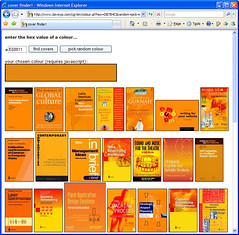
It’s so quick & dirty that you’ll need to enter a hex value for the colour you want to search for (e.g. FF8C00 or 9370D8) — if you’re not that familiar with the hex values, then try this page.
Alternatively, just hit the “pick random colour” button to make something up!
There are currently around 12,000 book covers that it knows the average colour for, but I’ll keep adding more once I’ve finished indexing them.
Month: January 2007
The Colours of North by Northwest
Colours, and the moods they evoke, play an important role in Hitchcock’s films.
With that in mind, I got ImageMagick to figure out the average colour of each of the 1000 frames for “North by Northwest” — you can see the results here.
To put the average colours into context, here they are annotated with a selection of scenes…

Getting the average colour of a given image got me wondering if it might be possible to do the same with the book cover scans on the OPAC. You could then virtually arrange and group books by their cover colours, in the same way that Huddersfield Public Library physically did last year:
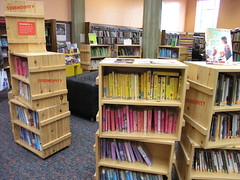
(image courtesy of Iman’s photostream)
1000 Frames of Hitchcock – part 2
Here’s the next batch of “1000 Frames of Hitchcock”:
The Pleasure Garden (1925) (60 seconds)
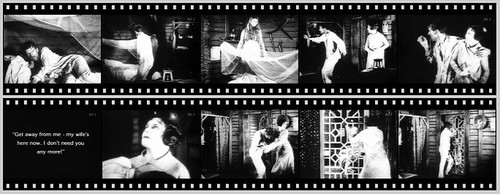
Strangers on a Train (1951) (60 seconds)

North by Northwest (1959) (60 seconds)

1000 Frames of Hitchcock – Spellbound (1945)
Slightly inspired by Douglas Gordon’s “24 Hour Psycho” video installation, here’s the first part of “1000 Frames of Hitchcock”:
Spellbound (1945)
…be warned, it’s a bandwidth hungry page!
The 1000 frames are fairly equally spaced and each represents a section of film lasting roughly 6 seconds.
Seeing as the next Dynix User Group Conference will be held in Barcelona, here’s a segment containing one of the Salvador Dali “Dream Sequences”:
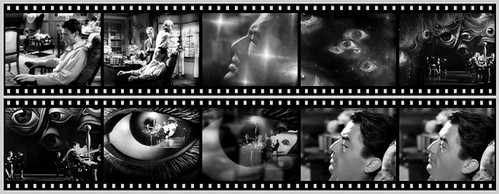
And, just to really tax your bandwidth and overload your computer, here’s a page that tries to show all 1000 frames in just 1 minute:
Hitchcock in 60 seconds – Spellbound (1945)
…the page might take a little while to load!
Shock horror — local area makes it onto BBC News site!
It’s not often that the area where we live gets a mention on the BBC News web site:
“Homes evacuated amid factory fire”
…in fact, the last time might well have been this story about a local inventor who was attacked by a squirrel.
Unfortunately the main road where we live is still closed by the police, so it’s going to be fun getting back home tonight!
Keeping an eye on your HIP
As promised to the HORIZON-L mailing list, here’s a Perl script we use to monitor our HIP server:
www.daveyp.com/files/stuff/monitor/monitor.pl
Once you’ve downloaded it, rename the file to monitor.pl
In summary, the script checks two URLs and sends an email to one (or more) email addresses if a trigger is reached:
(1) the first check is that your HIP home page is returning a 2xx HTTP status code
(2) the second check is that a HIP keyword search is returning results
Continue reading “Keeping an eye on your HIP”
“Smoke lingers ’round your fingers”
Now this is why I have absolutely zero interest in getting a job in London:
BBC News: Table-sized flat for £170,000
In case you’re not from around these parts, that’s:
- $336,074 US dollars
- €259,428 Euros
- $426,364 Australian dollars
- 3,664,289 Mexican pesos
- 14,821,889 India rupees
As a comparison, our 3 bedroom period terraced cottage (which is actually 2 cottages knocked together) set in a lovely rural location with oodles of wildlife cost us just £70,000.
Blyberg Rocks!
Given how quiet he’s been of late, I should have known John Blyberg was up to no good…
AADL.org Goes Social
I’m so envious that John is given the time to do all this by his management — I always seem to end up doing my coding during lunch breaks or at weekends — and I would kill a box full of cute kittens with my bare hands to be able to take on a project like this!

I was going to announce this week that Huddersfield are going live with user comments on the OPAC, but I kinda feel like an embarrassed fanboy now (mental note to self: “always announce things before John does, otherwise it just looks like you’re copying him!”).
One of the reasons for wanting comments is that our librarians are intrigued by some of the ratings our students have been giving items on the OPAC. For example, this new book on RFID was given a rating within a couple of hours of being placed on the shelf and no one has borrowed it yet — so, had the user already bought the book… was it a member of staff wanting to recommend the book to students… was it someone just seeing how the ratings work by picking a random book?
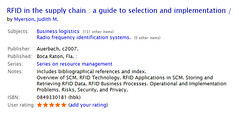
It’ll be interesting to see if the loan frequency for highly rated books goes up or just stays the same.
It’s really cool to see that John has released the code for SOPAC. I’ve thought of doing this for our OPAC tweaks, but wasn’t sure how useful it would be — much of it relies on a MySQL database for storing data outside of the library management system. Having said that, if anyone is interested in any of the things I’ve done, just give me a shout as I’m more than happy to share code.
Now, if I could just survive on 3 hours of sleep per night, I might have time to play catch up with AADL!
The Library Predict-o-matic 3000
Were you caught on the hop by the merger of Sirsi and Dynix?
Did the Ex Libris acquisition of Endeavor take you by surprise?
Were you amazed by the breaking news that LibraryThing is going to buy out Talis?
If the answer to any of the above is “yes”, then you need the…
Library Predict-o-matic 3000
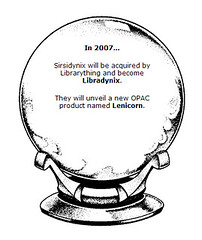
“Spooky” and “Eureka!” moments
Just spotted “Asking Non-Users Why They Don’t Use the Library” (LISNews):
From the Newtown (CT) Bee, C.H. Booth Library is looking for opinions about the library from an unlikely source: the people who do not use it. As part of a study for long-range planning at the library, made possible through a $9,000 grant awarded in 2006 by the Connecticut State Library, consultants Kevin McCarthy, director of Perrot Library in Old Greenwich and Christine Bradley, Connecticut Library Consortium executive director, have created a survey for local residents. To date, more than 300 surveys have been returned, a return rate that Mr McCarthy said at a meeting January 9 is very good.
At Huddersfield, we’ve been busy trawling our usage stats — firstly for our initial Equality Impact Assessment of opening hours, and more recently an analysis of non and low usage by staff and students.
We’ve only done an quick overview of non-usage (specifically usage of electronic resources, library borrowing, and number of visits to the library), but it’s thrown up some interesting trends such as:
1) Art & Design Students — only 20% of them regularly use our electronic resources, but (relatively speaking) they are heavy users of the library (visits and borrowing)
2) the older you are (apparently we’re not allowed to say “Mature Students” anymore), the less likely you are to use the library and it’s facilities — the drop off rate is fairly alarming, especially as we have a large number of students who didn’t come to us straight from doing their A Levels
3) female students are more likely to borrow books than males, but are less likely to make use of the library outside of the normal 9-5 opening hours
Continue reading ““Spooky” and “Eureka!” moments”